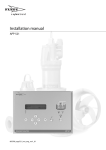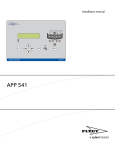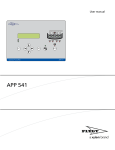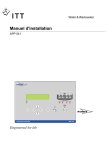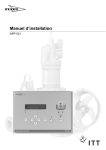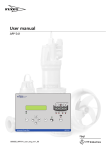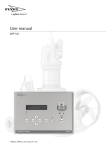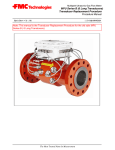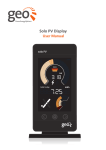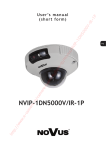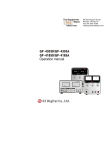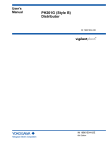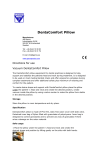Download APP541 Installation manual
Transcript
Installation manual APP 541 Esc Autamatic Pump Pilot 895684_app541_inst_eng_rev1_00 OK Reset APP 541 This manual is applicable to the following APP 541 versions: Hardware: Operator panel: I/O-module: Com-module: AFH1801 Rev 1.02 AHH1801 Rev 1.02 TMX1801 Rev 1.00 System Software: 2.20 Application: 1.00 © Copyright 2005 ITT Flygt AB. All rights reserved. No part of this manual may be reproduced or copied without the written permission of ITT Flygt AB. ITT Flygt AB P.O.Box 2058 SE-291 02 Kristianstad Sweden Tel +46 44 20 59 00 June 2005 This document may be changed without any prior notice. Contents Contents 1. 2. 3. 4. 5. 6. 7. Read this first................... 4 1.1. Product documentation .............. 1.2. Safety rules for the owner/ operator ...................................... 1.3. Guarantee .................................... 1.4. This manual ................................. 1.4.1. Symbols used ............................. 1.4.2. Abbreviations ............................ 4 4 4 4 4 4 Introduction..................... 5 Mechanical installation.... 6 3.1. Installation in explosive areas ..... 6 3.1.1. Installation in an equipment cubicle ....................................... 6 3.2. Level sensor installation .............. 6 3.2.1. 4-20 mA level sensor .................. 6 3.2.2. ENM-10 level regulator ............... 6 3.3. Mounting instructions ................. 7 3.3.1. Notice about mounting front seal according to IP 65 .................... 7 3.3.2. I/O-module ................................. 7 Electrical installation ....... 8 4.1. Power supply ............................... 8 4.1.1. Earthing (grounding) .................. 9 4.1.2. Overvoltage protection ............... 9 4.2. Emergency operation .................. 9 4.3. Connections ................................. 9 4.3.1. Digital inputs .............................. 9 4.3.2. Inversion of inputs ...................... 9 4.3.3. Analogue input ........................... 9 4.3.4. Digital outputs ........................... 9 4.4. Communication ......................... 10 4.4.1. Connection to a modem or radio .................................... 10 4.4.2. Connection to a PC using a fixed line .................................. 10 Wiring diagram 100-240 V AC ................. Wiring diagram 24 V DC Fault tracing................... Specification .................. 11 12 13 14 3 Read this first 1. Read this first 1.4.1. Symbols used Before starting installation of the APP 541 read this chapter carefully. It contains general information on documentation, safety and guarantee. Safety instruction 1.1. Product documentation Risk of personal damage. Documentation delivered with the APP 541. Check that this manual version is applicable to the delivered APP 541 version (see cover inlet). Safety instruction Risk of personal damage dangerous voltage. 1.2. Safety rules for the owner/ operator Special attention value • All government regulations, local health and safety directives must be observed. Risk of apparatus or component damage. • All danger due to electricty must be avoided. 1.4.2. Abbreviations 1.3. Guarantee CS = Central system • Modifications or changes to the unit/installation should be done only after consulting ITT Flygt. RTU = Remote Terminal Unit SCADA = Supervision Control And Data Acqvicition • Genuine spare parts and accessiories authorized by the manufacturer are essential for compliance with the terms of the guarantee. The use of other parts may invalidate the guarantee. 1.4. This manual In order to avoid repetition of information, this manual describes how one pump P1, should be read or entered. If a second pump or more pumps, are included in the installation, the corresponding steps must be repeated on those too. 4 Introduction 2. Introduction The APP 541 is a pump controller that consists of two parts, i.e. a DIN rail-mounted I/O module and a operator panel. The APP 541 can use a modem, GSM or radio to communicate with a SCADA system e.g. the AquaView. A special communication module is available for this purpose. Observe all precautions for handling electrostatically sensitive devices before opening the unit. The front surface of the APP 541 has a high degree of protection against moisture and dirt, but should always be installed so that it will not be unnecessarily exposed to water or the risk of external physical damage. The APP 541 may be used only in the manner specified by the manufacturer. The manufacturer does not allow any internal modifications to be made in the unit. Always keep this manual in the vicinity of the installed unit. 5 Mechanical installation 3. Mechanical installation 3.1. Installation in explosive areas 3.2. Level sensor installation The unit must never be installed in an explosive or flammable environment. N.B. See separate operation and installation manual for details of installation in the pump sump. For instructions concerning installation of the level sensors in such an environment see section 3.2. Level sensor installation. 3.2.1. 4-20 mA level sensor The sensor shield must be connected to the earth (ground) terminal of the APP 541 as shown in the diagram under “Analogue input” on page 9. If the pump is installed in an explosive environment, its thermal overload switch must be connected The sensor may be installed in an explosive or flammable environment, provided that an external Ex barrier is used. 3.1.1. Installation in an equipment cubicle 3.2.2. ENM-10 level regulator Ensure that the operating temperature of the cubicle is between 0 and 50° C. Heating will normally be required in winter if the cubicle is located outdoors or in a similarly cold environment. The cubicle temperature may become too high in summer if ventilation is inadequate. Heating of the cubicle is also recommended to avoid condensation. High level switch Low level switch Installation of the ENM-10 level regulator in the pump sump. ENM-10 level regulators may be installed in an explosive or flammable environment, provided that an intrinsically safe Ex barrier is used. 6 Mechanical installation 3.3. Mounting instructions 3.3.1. Notice about mounting front seal according to IP 65 The enclosure is designed for mounting into a rectangular hole in a larger cabinet door. Be careful not to get any grease in your eyes and avoid prolonged skin contact. Wash your hands afterwards. A rubber gasket will seal against the front surface of the cabinet door. Studs welded to the rear of the front plate must enter into holes in the cabinet door. To assure a front seal according to IP 65 the front unit has to be mounted on to a rigid and smooth surface. • Use the paper template to mark off the opening to be made in the cubicle door. • Tape the template to the cubicle door. Mark with a centre-punch the positions of holes 5 and 8 in the template. If otherwise mounted on to a textured surface and/or flexible steel plate cabinet, it is normally necessary to apply a thick layer of grease on the sealing surfaces to obtain sealing according to IP 65. • First drill a small pilot hole at every punch mark. Then open up the screw holes marked 5 in the template to 5 mm. Suitable grease is "Gleitmo 1810v". After application wipe gently all overflowing grease away. • Drill 8 mm dia. holes marked 8 in the template for the corners of the opening in the cabunet door. 200 184 5 8 Do never use grease containing silicone since this might seriously damage sensitive electric contact surfaces inside the cabinet! 8 3.3.2. I/O-module 5 8 The I/O-module has clamps at the rear. • Place the unit in a suitable location on a DIN rail. 135 119 • Connect the cables supplied between the operator panel and the I/O-module. Secure the cable so that they will not be nipped. 8 Note: The Ethernet cable is a crossover UTP RJ 45 cat 5e. The cable length is 1.8 m (max length 3 m). 8 8 5 5 • Then tape with masking tape between the outsides of the holes 8. See the drawing. 8 8 8 8 • Use a jigsaw or some other suitable tool to make the opening for the operator panel in the cubicle door. • Place the operator panel in the opening. Fit the washers and nuts, and tighten them firmly. 7 Electrical installation 4. Electrical installation 4.1. Power supply Warning A separate fuse must protect the APP 541 power supply. Flygt recommends the use of a miniature circuit breaker that opens on all poles. Do not open machine with the grounding wire disconnected. One I/O module is designed to operate on 100 to 240 V AC power supply. The unit can also operate on 24 V DC as backup power supply and can charge the backup battery when the mains power supply is on. More than one live circuit. The electric wiring should be done only by an authorized electrician. All electrical installation work must be carried out with the equipment disconnected from the power supply, without any possibility of being made live, and in accordance with local regulations. An ON / OFF isolating switch must be provided adjacent to the installation to enable the APP 541 to be isolated from the power supply. This isolating switch must be located close to the APP 541 and must be easily accessible to the user. And there is one model designed to operate at 24 v DC. The I/O module also supplies power to the operator panel. N:B. Max. current availabe to the modem: 24 VDC, 180 mA, 4.5 Watt The isolating switch should be marked to show that it belongs to the APP 541. When installing electronic measuring and control systems, it is important that the cabling be specified and run so as to minimize interference by electric and magnetic fields. The many potential sources of such interference include relay coils, solenoid valves, switches, thyristor units, earth (ground) currents and static electrical discharges. Susceptibility to interference also varies with the electrical environment, i.e. due to factors such as cable lengths, screening and whether or not interference suppression is provided. Many problems can be prevented by good design. Cables carrying signals of different types (for example, analogue and digital signals) must be run separately. Power and signal cables must never be run in close proximity to one another. 8 Electrical installation 4.1.1. Earthing (grounding) 4.3. Connections An equipment earthing (grounding) conductor must be connected to terminal 3 (see Wiring diagram). The terminal blocks on the APP 541 are described below and are shown in the “Wiring diagram 100-240 V AC” on page 11. The earthing conductor should be connected to the best possible earth, such as an earthed mounting plate or an earth rod. Remember that the earthing conductor must be as short as possible. 4.3.1. Digital inputs The digital inputs are connected to terminals 28 -59 (see the “Wiring diagram 100-240 V AC” on page 11). Each input has its own power supply. The shields of all shielded cables must be earthed. 4.1.2. Overvoltage protection 4.3.2. Inversion of inputs Flygt recommends that the mains power supply unit be provided with overvoltage protection (with lightning protection). Since this will make the APP 541 less sensitive to overvoltage, it will enable it to be used in more severe environments. The digital input signals can be inverted to change the operating mode from closing to opening, or vice versa. 0 indicates no inversion. This is the default state. See the User manual. 4.3.3. Analogue input The protection should be connected in series with the power supply, preferably to a separate earth (ground), such as an earth rod, although connection to the earth busbar in the distribution box may sometimes suffice. The analogue input (4-20 mA) is connected to terminala 4 - 5 (see the Wiring diagram) and has its own power supply. The input can carry a maximum total voltage of 16 V. A 6-10 mm2 earthing wire should be used to connect the overvoltage protection to earth. 4.2. Emergency operation 1 When the control unit is in the normal running mode a relay (1) will be activated. If the control unit should fail, due to software, hardware or power supply fault, the relay will be deactivated (0). 2 3 This relay can be connected between a high level switch, a timer and a power supply relay controlling the pump. This function will provide an emergency function that will run the station on the high-level switch even if the control unit is out of operation. 4 5 6 7 8 9 10 + - • Emergency operation is delayed by 5 seconds after the supply has been switched on. • External Manual-0-Auto switch is located close to the operator panel. Analogue terminals for: 3 4 5 7-8 9-10 Shield Red + Black Input for current transformer with 0-1 A AC output Input for current transformer with 0-1 A AC output 4.3.4. Digital outputs The digital outputs are connected to terminals 11-22 (see the Wiring diagram). The outputs are potential-free, relays with a max. rating of 2 A at 230 V AC or 30 V DC. 9 Electrical installation 4.4. Communication To install the communication module, in the operator panel, follow the instructions below: N:B: Make sure that the power supplay is isolated! 2 1 1. Release the four screws (1) holding the rear cover to the front of the unit. 2. Lift off the rear cover (2). Unpack the communication module (3). 3 4 3. Place module (3) in the position (4), (see above). 4. Make sure it is securely in position. 5. Refit the rear cover. 4.4.1. Connection to a modem or radio Connect the enclosed dedicated modem cable from the modem/radio to the RS232 connector on the COM1. Connect the modem/radio to its own power supply. 4.4.2. Connection to a PC using a fixed line Connect a dedicated null-modem cable from the PC to the RS232 connector on the COM1. N.B. A common misunderstanding is to confuse the use of a modem cable and a null-modem cable. Normally a modem cable has a male contact in one end and female contact in the opposite end. The null-modem cable has normally female contacts in both ends. Note that they are different connected internally to the contact pins. Be sure to use the right cable for each purpose. N.B. For configuration, see the User manual. 10 Wiring diagram 100-240 V AC 5. Wiring diagram 100-240 V AC Power supply (see section 4.1): Power supply, phase, neutral and ground: 100-240V AC, 50/60 Hz. (1, 2, 3) Analogue inputs (see section 4.3.3): B Level sensor input, 4-20 mA. (4, 5, 6) C Current transformer for pump 1/3, 0-1 A AC (7, 8) D Current transformer for pump 2/4, 0-1 A AC (9, 10) Digital outputs (see section 4.3.4): E Start pump 1 (11, 12) F Start pump 2 (13, 14) G Start pump 3 (15, 16) H Start pump 4 (17, 18) I Common alarm output (19, 20) J Emergency operation (21, 22) Operator panel (see section 3.3.1): K Operator panel 24 V DC (23, 24) L Communication to operator panel (25) Power supply (see section 4.1): M Battery backup 24 V DC (Option) (26, 27) Digital inputs (see section 4.3.1): N Motor protector to pump 1. (28, 29). If not used, jumper the input. O Start-feedback from pump 1. (30, 31) Q R S Start feedback from pump 2. (34, 35) Motor protector to pump 3. (36, 37).. Start feedback from pump 3. (38, 39) T U V X Y Z Motor protector to pump 4. (40, 41) Start feedback from pump 4. (42, 43) General purpose input 1. (44, 45) General purpose input 2. (46, 47) General purpose input 3. (48, 49) General purpose input 4. (50, 51) AA General purpose input 5. (52, 53) AB General purpose input 6. (54, 55) AC General purpose input 7. (56, 57) AD General purpose input 8. (58, 59) U AD 52 53 54 55 56 57 58 59 t8 e os pu in pu rp al r ne al G en er G en er AC G rp en os er e al in pu pu t5 rp G en os er e in al p pu ut rp 6 os e in pu t7 pu t4 in pu t3 in os e os e rp al pu al AB AA Z rp in p os e G en er al pu rp os e pu rp pu ut 1 P4 k ac ee db G en er al pr M M ct e ot tf B ba atte ck ry up ot or pr ot ec St to ar rP tf 1 ee db M ot ac or k P1 pr ot ec to St ar rP tf 2 ee db ac k P2 M ot or pr ot ec St to ar rP tf 3 ee db ac k P3 or ot 4 P or Y 44 45 46 47 48 49 50 51 36 37 38 39 40 41 42 43 28 29 30 31 32 33 34 35 X V pu t2 T S Motor protector to pump 2. (32, 33) in R Q P ar 26 27 O St N M P G en er A pu e G APP 541 A B C 10 D 11 12 E H N.B. Terminals 6, 8 and 10 are connected together internally. N.B. Terminals 29, 31, 33.......59 are connected together internally. N.B. I and J are activatded at normal operation. 11 ne io 25 24 V 23 24 er 21 22 J r er at op nc y ge on m 19 20 I l n 18 m pu ar t 17 G al ar m p m m pu ar t 15 16 D pe C ra to to rp a t ou F 4 3 p 2 p um tp 13 14 To O pa pe ne ra l to 9 O 8 Em 7 Co 6 St 5 St 4 ar Cu 3 St lS ve gn Le Si 2 al V 30 Su 1 5 11 er Po w /2 pp ly AC APP 541 en so r G inp rr ND e 40- n 20 1A t T r m Cu AC ans A fo rr rm 0- ent er 1A T P1 AC ran /P sf 3 or m e r St P2 ar /P tp 4 um p 1 MIO 501 K L Wiring diagram 24 V DC Wiring diagram 24 V DC A Ground (3) Analogue inputs (see section 4.3.3): B Level sensor input, 4-20 mA. (4, 5, 6) C Current transformer for pump 1/3, 0-1 A AC (7, 8) D Current transformer for pump 2/4, 0-1 A AC (9, 10) Digital outputs (see section 4.3.4): E Start pump 1 (11, 12) F Start pump 2 (13, 14) G Start pump 3 (15, 16) H Start pump 4(17, 18) I Common alarm output (19, 20) J Emergency operation (21, 22) Operator panel (see section 3.3.1): K Operator panel 24 V DC (23, 24) L Communication to operator panel (25) Power supply (see section 4.1): M Power supply 24 V DC input or Battery backup 24 V DC (Option) (26, 27) Digital inputs (see section 4.3.1): N Motor protector to pump 1. (28, 29) O Start-feedback from pump 1 (30, 31) Q R S Start feedback from pump 2. (34, 35) Motor protector to pump 3. (36, 37). Start feedback from pump 3. (38, 39) T U V X Y Z Motor protector to pump 4 (40, 41) Start feedback from pump 4. (42, 43) General purpose input 1. (44, 45) General purpose input 2. (46, 47) General purpose input 3. (48, 49) General purpose input 4. (50, 51) AA General purpose input 5. (52, 53) AB General purpose input 6. (54, 55) AC General purpose input 7. (56, 57) AD General purpose input 8. (58, 59) AD ut in p se pu in po ur lp a er al en er t8 7 in pu t6 os e rp o rp pu en G G G en er al pu rp o se se in pu t5 4 3 ut os e en er al G AC 52 53 54 55 56 57 58 59 in p 2 ut in p os e AB AA Z ur p ur p al p er en er en G G os e ur p G en er al p ur p os e in p ut ut 1 P4 ac k db al p G en er pr M M ct e ot fe e B ba atte ck ry up ot or pr ot ec St to ar rP tf 1 ee db M ot ac or k P1 pr ot ec to St ar rP tf 2 ee db ac k P2 M ot or pr ot ec St to ar rP tf 3 ee db ac k P3 or ot 4 P or Y 44 45 46 47 48 49 50 51 36 37 38 39 40 41 42 43 28 29 30 31 32 33 34 35 X V pu U in p T S Motor protector to pump 2. (32, 33) al p R Q P ar t 26 27 O St N M P APP 541 A B 8 C 9 10 D 11 12 E G 18 H N.B. Terminals 6, 8 and 10 are connected together internally. N.B. Terminals 29, 31, 33.......59 are connected together internally. N.B. I and J are activatded at normal operation. 12 op rm en cy al a er g m 19 20 21 I 22 J io 24 n V O DC pe ra to to rp an To el O pa pe ne ra t l or 17 er at ou t 15 16 on p ar t pu m um ar tp F 4 3 p 2 13 14 Em 7 Co m 6 St 5 St 4 p V 30 3 pu m 2 ar t 11 1 5 Po w er /2 Su pp ly AC APP 541 St Le ve l Si Sen gn s al or Cu G inp r ND 40- ren 20 1A t T r m Cu AC ans A fo rr rm 0- ent er 1A T P1 AC ran /P sf 3 or m e rP St ar 2/ tp P4 um p 1 MIO 501 23 24 K 25 L Fault tracing 6. Fault tracing Power on LED does not light up. Alarm status LED red. Is power supply off? No Alarm status LED Red Yes Check the external mains switch and mains fuse or miniature circuit breaker. Check Alarm log menu Alarm: High temperature, P1 - P4 Contact FLYGT service agent No Go to next Alarm. Yes Yes Thermal overload switch in motor winding has tripped due to high temperature. No Pump fails to start No Contact FLYGT service agent Pump is damaged (e.g. bearing failure, winding fault); pump impeller is jammed Contact FLYGT service agent Blocked, displays steady light (Pump status indicator, red LED) Yes Check that Manual 0-Auto selector is set to Auto. If not Manual-0Auto is used, jumper the auto input. Alarm: Tripped, P1 - P4 Check that Auto is selected in from P1 Status to P4 Status menu as appropriate. Alter if necessary External motor protection has tripped Thermal overload switch must be wired as shown in wiring diagram. If not used jumper the input. No Go to next Alarm. Yes Yes No Contact FLYGT service agent Alarm: Max run, P1 - P4 No Contact FLYGT service agent 13 Yes Check external motor protector . Pump is running on two phases Pump is damaged (e.g. bearing failure, winding fault); pump impeller is jammed Check start and stoplevels from Start level 1, Stop level 1 to Start level 4 and Stop level 4 menus as appropriate. Check time setting in Max run time menu and adjust if necessary. Pump impeller is damaged and delivering insufficient flow. Level sensor is faulty. High-level switch or start/ stop switch is faulty. Specification 7. Specification Digital inputs Relay outputs Analogue inputs Processor Battery back-up for the real time clock Current consumption Fuses Rated voltage Relay output Rated output for modem Operating temperature Storage temperature Humidity (non-condensing) Degree of protection EMC emission standard EMC immunity standard LVD electrical safety Display Push buttons Indications Dimensions control pane (l × w × h) Dimensions I/O-module (l × w × h) Weight of operator panel Weight of I/O-module Mounting Terminals Cable from I/O unit to operator panel Level sensor types Total of 16: Pump fault, circuit tripped, start feedback, high level switch, thermal overload switch, external Manual-0-Auto switch, external alarm, general purpose Total of 6: Start pump, common alarm, emergency operation. Total of 3: Analogue level, 4–20 mA, analogue current CT 0-1 A AC 16-bits Motorola HCS12 3 V Lithium, Battery will normally last for 8 years. < 50 mA 100/240 V AC: T3. 15 A 24 V DC: 1.1A 100-240 V AC 50/60 Hz or 24 V DC (18 - 36 V DC) Max. load 240 V AC/2 A 24V DC 180mA (when RTU is powered with 100/240 V AC). Operating temperature -20° C to + 50° C. The LCD display will respond more slowly at temperatures below 0° C -10° C to + 70° C 90 % RH IP 65 Front, IP 20 EN 61000-6-3 EN 61000-6-2 EN 61010-1 LCD 2 x20 character 8 12 LEDs 220 x 150 x 25 mm 210 x 149 x 47 mm 1 kg 0.9 kg Cabinet Signal: 1.5 mm2 Power: 2.5 mm2 Ethernet cable is a crossover UTP RJ 45 cat 5e. The cable length is 1.8 m (max length 3 m). External level sensor 4-20 mA External level regulator ENM-10 14 www.flygt.com
















